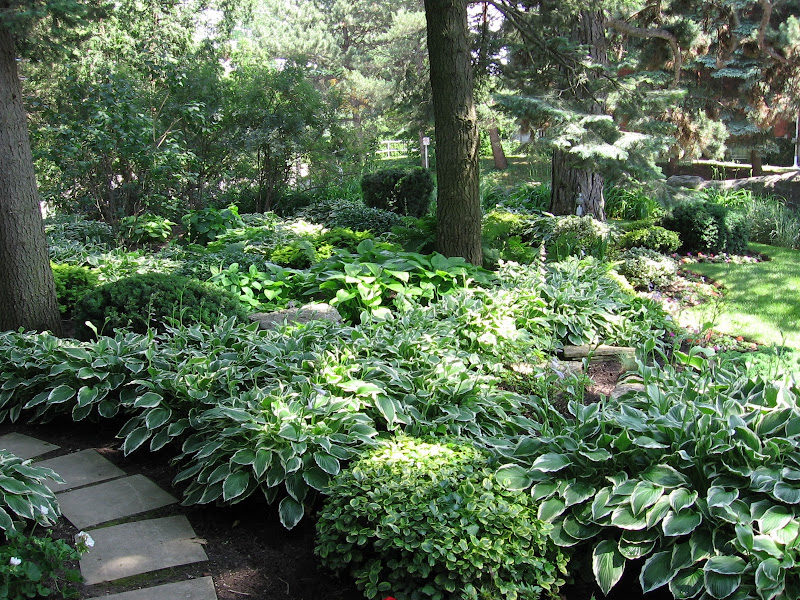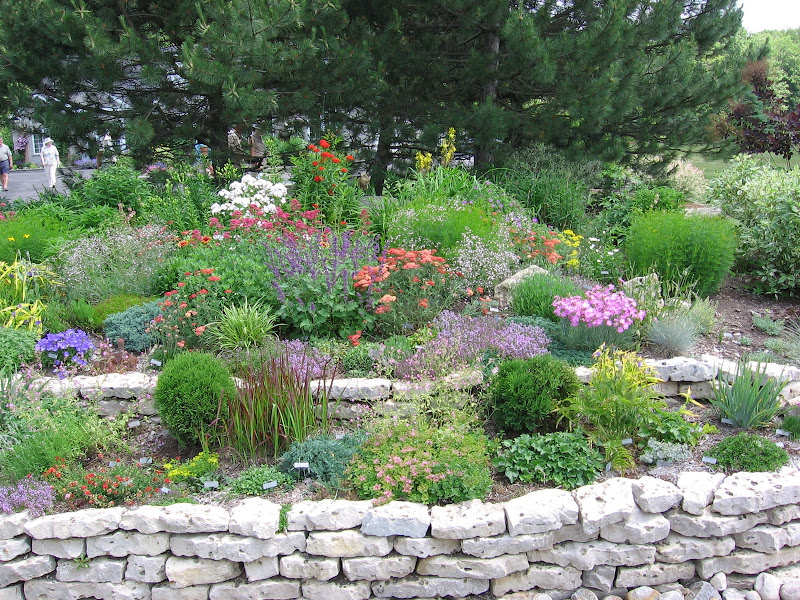Hope this year brings you health, happiness and much fun in the garden :)
January in Ontario can be cold, rainy, snowy, freezing, uncharacteristically warm, windy and/or blizzard-y. These changes sometimes take place within the space of a week!! (Weird, it was never like this when I was a kid!) Anyway, what January is NOT is a good month to be out in the garden
But January is a terrific month for planning.
Planning should be an essential part of your garden design. I know it's much more fun to choose seeds from catalogues and pretty plants at the nursery but you can waste a lot of time, energy and money by not planning ahead.
I have decided to split the topic of planning a garden into 2 parts: this month I will give you tips on how to design a brand new garden and next month we'll figure out how to change or fix up an existing garden.
Let's say you have bought a house with little or no landscaping at all.
Where do you start?
One of the easiest but most expensive ways is to hire a Landscape Architect or Garden Designer to plan your yard. Most companies will do both hardscaping ( which refers to any part of the garden that is non-living) like walkways, patios, decks, garden sheds, cabanas, arbours, walls and fences as well as softscaping (plants) including trees, shrubs and flowers.
If you would like to save some money and have the satisfaction of doing it yourself, you must still ask yourself many of the questions Designers would ask:
How do you plan on using the garden? Will it be a practical space to play or should it just look pretty? Is it important that it acts as an "outside room"?
Will you need a deck or patio? Do you like to eat outside or entertain outdoors?
Do you have children or grandchildren who will want space to play? What about a pet - will the dog need an area to run? Would you like a swimming pool?
Gardeners in the north ( in areas that experience 4 seasons) should consider garden elements that will look good in winter as well as spring, summer and autumn.
What's the exposure in your garden? Is it sunny all day long or are there large trees that provide a lot of shade? Are there strong prevailing winds that can damage sensitive plants?
Do you like gardening? Will you be willing to devote a few hours (or a lot of hours) to working in the garden? Planting is the easy part - the work comes when the garden must be maintained.
I guess what I am trying to emphasize is analyze your situation. If you can do that, you will create a yard that fits your needs.
So you've decided that you would like a patio or deck with pleasantly planted borders around the edges.
OK - good start. You can either hire someone to build the patio or do it yourself.
But what about the borders? Should you look at gardening books or magazines or internet sites and choose your favourites?
Ideas of what others have done are a terrific start but remember to personalize them into your own situation. Planting sun-loving shrubs and perennials in a yard that gets shade most of the day will kill those plants.
And should you just do softscaping? I would not recommend it.
If you think of the hardscaping as The Bones of the garden, then I recommend that you invest in the best Bones you can afford - the fences, the paving and the structures.
Make sure each bed that you plan has a pleasing shape and think of the hard elements first. Perhaps an arbour or an obelisk.
A bird bath or sculpture.
Boulders, river rock or rock walls.
Attractive garden sheds or play houses.
Quality structures remain beautiful as they age.
Once the Bones have been decided upon and placed, you can start thinking about the beds.
I would recommend deciding in this order: trees - deciduous and evergreen; shrubs; grasses; perennials and annuals.
I used to plan borders using graph paper, pencil and really good eraser!! Now it is more popular to plan online but either method works.
Measure the space you have (or estimate) and then plan in the plants that would do well together in your yard's environment and space.
Remember - PLANTS GROW!!! I know that sounds ridiculous to say but honestly, the number of people I hear complaining that such and such a shrub or evergreen is 8x the size that they planted it - I feel like saying: did you think it wouldn't GROW???
So when drawing in blobs to represent trees, shrubs and even perennials, always check their mature spread as well as their height.
Look how a border can fill in and "spread".
So I will leave you with this summary of ideas when planning a garden:
1. Decide what is most important for you in your yard
2. Invest in excellent quality hardscape
3. Include hard elements into borders
4. Think trees, shrubs, grasses, perennials and annuals, in that order.
If you plan a garden well, the outcome should be very satisfying and pleasing.














7 comments:
Welcome to Blotanical, interesting blog
Un Saludo
I just discovered your blog. LIked the questions you posed for anyone planning a garden. Your principle fit much with those I have written about in earlier postings. Here on Lake Michigan I have the benefit of the view which adds so much to my blog photos. Each month I pick one or two blogs to continue to follow and I am choosing yours. Like it. Jack
Outstanding advice! It's good to have a plan. And for people who don't know where to start with plants, they should take their space diagram (with dimensions) to the garden center for some practical suggestions.
Welcome to Blotanocal!
I liked your blog, more the stone walls. I'll try to plan my garden.
Visit my blog, too!
Nadezda
http://northern-garden.blogspot.com/
like your blog, and so I have nominated you for the Versatile Blogger Award in my last post. Enjoy!
Nadezda
http://northern-garden.blogspot.com/
Thanks for all your comments! I really enjoy connecting with other garden enthusiasts.
Astrid
Fantastic advice! Some of it I have realized after making mistakes - like not planning enough 'bones' of the garden or realizing how big things get! Now I really try to plant trees and shrubs however far apart they need to be, no matter how sad they look at first.
Post a Comment